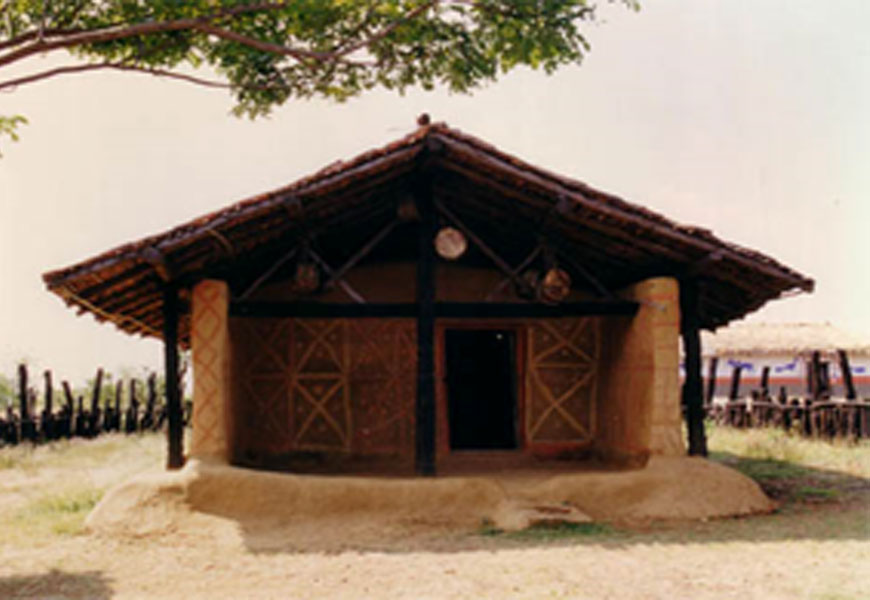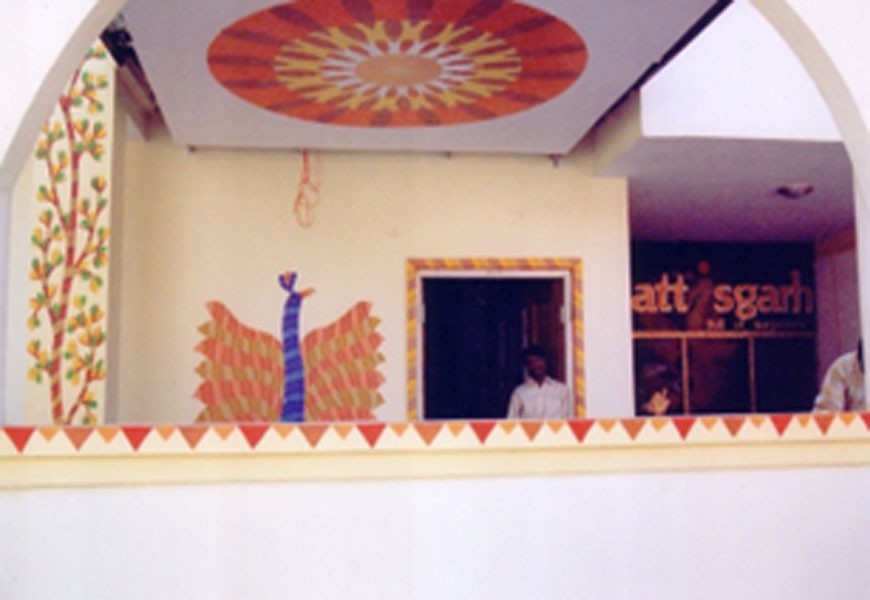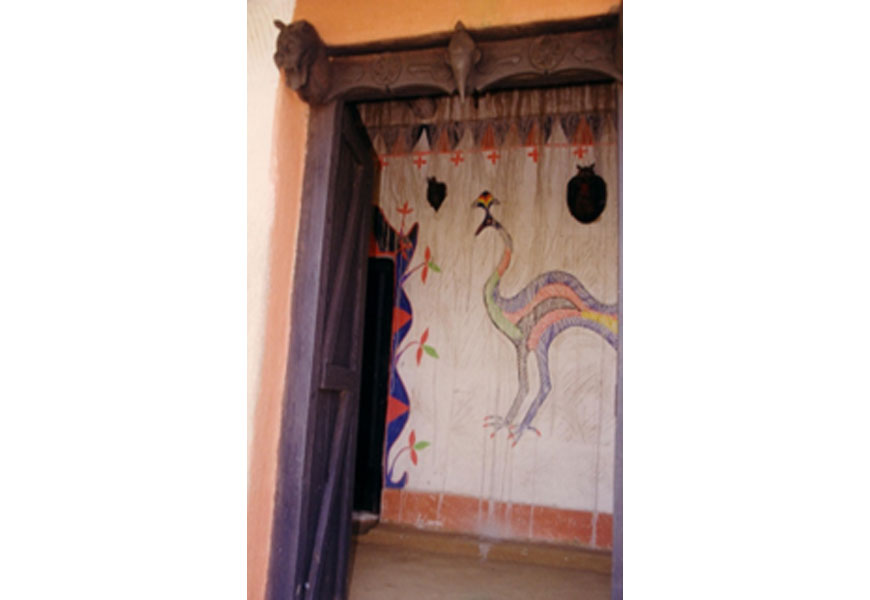Wall Paintings
Many of the present day Indian tribal communities indulge in wall painting and floor decoration. Wall decoration creates a harmonious atmosphere in the house. The decoration of the house is done in two ways – painting and relief work. Bas relief work is done on the inner walls of the house, around the central courtyard. It is usually done during the construction of the house when the walls are still wet. The walls are rubbed clean to obtain a smooth structure. Dowels or pinches of clay are quickly and deftly applied directly on the mud walls to form a ridges, lines, curves and dots, in order to produce the desired shapes. The motifs are generally geometrical patterns, foliates form, lotuses, elephants, horses, other animals and human figures. In order to prevent clay surfaces from cracking and crumbling a fresh coat of clay is applied from time to times.
They decorate walls in colour or relief. Mud walls are cleaned and coated with a paste of cow dung, when it dries, a coadding of geru or red clay is applied to give body and colour to background. Powdered rice flour mixed with water or milk and sindur provide two pigments from which design emerges. Wall paintings were executed to disappear within a season so that other painting appropriate to the change of season or the next family ritual could be drawn on the same wall. Many of these communities represent almost similar kind of cultural level and life pattern as the people living in rock shelters. The earliest two-dimensional art was carried out by these artists on the walls of their huts.
The tribal of Madhya Pradesh like Gond, Baiga and pradhan generally decorate their walls while finishing their work of making the hut. They make forms pasting extra mud pressing or pinching it into patterns in high or low relief, while the wall is still being completed. Entire work is free hand. The mud of the wall should be damp throughout the process. After making pattern the mud plaster is applied in ( a finger thick layer ). This coat is left to dry for a day or two. Finally it is given a thin coat with a mixture of fresh cow-dung and soft white clay (chuna mitti) diluted in water. It should be renewed at least once a year.

The women of Chattisgarh make elaborate votive forms with cow dung on their walls on hariyali amavasya, the moonless night during the month of savanna, as good omen and to safe guard their houses from evil spirits. They draw four furrow like lines, and composed figures on the main entrance of the house. Human figures engaged in activities like hunting riding dancing are painted along these lines. Motifs like sun, moon, flowers, plants, are also portrayed on these lines. These paintings are called ‘savanaahi’. The women of Ghasiya tribe are extremely adept at wall decoration, relief work and painting. The Korka tribal of Betul and Hoshangabad keep their dwellings spotless by plastering them with cow dung and mud. The tradition of wall painting does not appear to have developed much in their community. Bharia women decorate their houses thick lines embossed on the walls.
The wall decoration of Chehindwara and Shehdol region are generally simple. Pando tribes of Bilaspur generally imitate the art form of their neighbouring communities and do not have an exclusive tradition of painting. The Ahir of Chattisgarh love to paint and decorate the walls of their home with geometrical representation. Some tribal of Chattisgarh have acquired painting skill from professional painters who travel in rural areas to do painting on house walls.

The region of Sarguja enjoys a rich tradition of wall decoration. The Ahir, Bargaya, Baiga, Ghasia and Gong of this region all have a long tradition of wall painting. The Rajwars have inherited the richest and more exclusive tradition of wall decoration Haldi Bazar of Bilaspur, Doomaria, Mahendragarh, Sonagara of Sarguja district and Metnagar and Doomarkona of Raipur district exemplify some of the most artistic geometrical representation. The image of goddess called Mangala Devi is also painted on the interior walls of their houses. Binjhwars of Raigarh make some beautiful paintings on wall of their home during diwali and wedding. These tribal illustrate simple forms with bold and thick lines. Binjhwar’s of Bilaspur also decorate the site of their karma and saila dances with simple wall paintings

The hunter tribe of Bilaspur ( Kashgharna) paint colour full images of Mahadeo and rama on walls for special occasion. The tribal of Mandala District paint votive paintings to celebrate the birth of Krishna known as Kanhaiyaaathe. They are static paintings which are painted by mixing karia mitti (black soil) ramraj (yellow ochre mud) and geru ( red ochre mitti) with betal leaf juice. The painting of this style was also created by Ahir and Rauts of Chattisgarh. Krishna surrounded with his cows and gopi carrying milk pots on their head, is generally the theme depicted in these paintings. Nagesia and Kanwar tribals deeply influenced by Hindu culture and paint walls during Diwali. Saora of Raigarh bear little resemblance to Saora of Orissa.
The Saoras who live in the hills of karaput and Ganjam, built their houses with thick mud walls, which provides a canvas for some remarkable wall paintings. The Saoras work on walls washed with a red clay, in paints made of white rice powder on black ash. Yellow, ultramarine blue, and black are also used at times to enhance the effect. Icons are drawn by kundan- the village sorcerer. The paintings of Saora community are linked to the healing processes of decease, save child birth and other life events. The pictures are painted in the honour of the dead, to avert disease and to celebrate certain festivals. They are especially interesting as being inspired by dreams and so portraying what the artist has visualized about life hereafter. They are regarded as alive, full of magic and are made foe use rather than display. They are intended to flatter the Gods, demon and ghosts who might otherwise attack the home. They use single triangle to depict torso. Some tribe use rectangle, but triangle seems to be common shape for depicting human face. Sometimes paintings are done on festive occasion and sun, moon, icon of tutelary spirits and ghosts from the form the content of the painting. Contemporary motifs like bicycle, motor car, and airplanes are also used.


